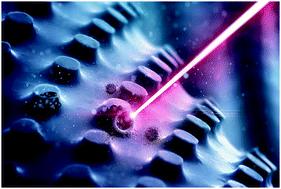当前位置:
X-MOL 学术
›
J. Mater. Chem. B
›
论文详情
Our official English website, www.x-mol.net, welcomes your
feedback! (Note: you will need to create a separate account there.)
Site-specific release of reactive oxygen species from ordered arrays of microchambers based on polylactic acid and carbon nanodots.
Journal of Materials Chemistry B ( IF 6.1 ) Pub Date : 2020-07-15 , DOI: 10.1039/d0tb01148g Alexey V Ermakov 1 , Valeriya L Kudryavtseva , Polina A Demina , Roman A Verkhovskii , Jiaxin Zhang , Ekaterina V Lengert , Andrei V Sapelkin , Irina Yu Goryacheva , Gleb B Sukhorukov
Journal of Materials Chemistry B ( IF 6.1 ) Pub Date : 2020-07-15 , DOI: 10.1039/d0tb01148g Alexey V Ermakov 1 , Valeriya L Kudryavtseva , Polina A Demina , Roman A Verkhovskii , Jiaxin Zhang , Ekaterina V Lengert , Andrei V Sapelkin , Irina Yu Goryacheva , Gleb B Sukhorukov
Affiliation

|
Non-destructive, controllable, remote light-induced release inside cells enables studying of time- and space-specific surface-mediated delivery of bioactive compounds, which is an important approach in a wide range of biomedical tasks, especially those related to the control of cell growth, regenerative medicine, and self-disinfecting structures such as catheters. In this regard, the elaboration of encapsulation and controlled release of oxidative species is in high demand due to its versatile applications. One of the obvious candidates for such species is hydrogen peroxide. However, the delivery of hydrogen peroxide to the site of interest with high temporal and spatial precision remains challenging due to the active and unstable nature of the substance. We hereby present an approach to encapsulate and store a hydrogen peroxide-containing solid compound (sodium percarbonate) in the free-standing arrays of biopolymer-based microchambers. In this regard, we use solid-state encapsulation enabling high payload ability, followed by isolated storage in order to prevent contact of the cargo with water. Monitoring of the release profiles reveals the encapsulation of sodium percarbonate with little leakage for up to 24 hours. Microchambers are fabricated with predetermined size and spatial distribution, which allows the release of extremely small amounts of cargo (10–30 pg) with high spatial accuracy. Microchambers are made of polylactic acid and functionalized by carbon nanodots, which provide biocompatibility and biodegradability of the whole system together with responsiveness towards NIR light. These chambers facilitate both ultrasound-assisted burst release and laser-driven carbon nanoparticle-assisted precise release of extremely small, controlled amounts of a few picograms of hydrogen peroxide in submerged conditions. Microchambers loaded with sodium percarbonate provided adhesion and high viability of mouse fibroblasts over 24 h of exposure. The developed system opens an exciting avenue for prospective delivery routes in a number of areas such as wound healing by time and site-specific release.
中文翻译:

从聚乳酸和碳纳米点的有序微腔阵列中特定位置释放活性氧。
细胞内无损,可控,远距离光诱导释放使得能够研究时间和空间特定的表面介导的生物活性化合物的递送,这是广泛的生物医学任务中的重要方法,尤其是与控制生物医学相关的任务。细胞生长,再生医学和自我消毒结构,例如导管。在这方面,由于其广泛的应用,对氧化物质的包封和控制释放的详细说明非常需要。这种物质的明显候选者之一是过氧化氢。然而,由于该物质的活性和不稳定性质,以高的时间和空间精度将过氧化氢输送到目标部位仍然具有挑战性。我们在此提出一种在基于生物聚合物的微腔室的独立式阵列中封装和存储含过氧化氢的固体化合物(过碳酸钠)的方法。在这方面,我们使用固态封装以实现高负载能力,然后隔离存储以防止货物与水接触。监测释放曲线可发现过碳酸钠的封装情况,长达24小时几乎没有泄漏。微型腔室的制造具有预定的尺寸和空间分布,从而可以以很高的空间精度释放极少量的货物(10–30 pg)。微腔室由聚乳酸制成,并通过碳纳米点功能化,可提供整个系统的生物相容性和生物降解性以及对近红外光的响应能力。这些腔室可在水下条件下,促进超声辅助的猝发释放和激光驱动的碳纳米颗粒辅助的极小,可控量的几皮克过氧化氢的精确释放。装有过碳酸钠的微腔室在暴露的24小时内可提供小鼠成纤维细胞的粘附力和高生存力。所开发的系统为许多领域的预期递送途径开辟了令人兴奋的途径,例如按时间愈合伤口和特定部位释放。装有过碳酸钠的微腔室在暴露的24小时内提供了小鼠成纤维细胞的粘附力和高生存力。所开发的系统为许多领域的预期递送途径开辟了令人兴奋的途径,例如按时间愈合伤口和特定部位释放。装有过碳酸钠的微腔室在暴露的24小时内提供了小鼠成纤维细胞的粘附力和高生存力。所开发的系统为许多领域的预期递送途径开辟了令人兴奋的途径,例如按时间愈合伤口和特定部位释放。
更新日期:2020-09-16
中文翻译:

从聚乳酸和碳纳米点的有序微腔阵列中特定位置释放活性氧。
细胞内无损,可控,远距离光诱导释放使得能够研究时间和空间特定的表面介导的生物活性化合物的递送,这是广泛的生物医学任务中的重要方法,尤其是与控制生物医学相关的任务。细胞生长,再生医学和自我消毒结构,例如导管。在这方面,由于其广泛的应用,对氧化物质的包封和控制释放的详细说明非常需要。这种物质的明显候选者之一是过氧化氢。然而,由于该物质的活性和不稳定性质,以高的时间和空间精度将过氧化氢输送到目标部位仍然具有挑战性。我们在此提出一种在基于生物聚合物的微腔室的独立式阵列中封装和存储含过氧化氢的固体化合物(过碳酸钠)的方法。在这方面,我们使用固态封装以实现高负载能力,然后隔离存储以防止货物与水接触。监测释放曲线可发现过碳酸钠的封装情况,长达24小时几乎没有泄漏。微型腔室的制造具有预定的尺寸和空间分布,从而可以以很高的空间精度释放极少量的货物(10–30 pg)。微腔室由聚乳酸制成,并通过碳纳米点功能化,可提供整个系统的生物相容性和生物降解性以及对近红外光的响应能力。这些腔室可在水下条件下,促进超声辅助的猝发释放和激光驱动的碳纳米颗粒辅助的极小,可控量的几皮克过氧化氢的精确释放。装有过碳酸钠的微腔室在暴露的24小时内可提供小鼠成纤维细胞的粘附力和高生存力。所开发的系统为许多领域的预期递送途径开辟了令人兴奋的途径,例如按时间愈合伤口和特定部位释放。装有过碳酸钠的微腔室在暴露的24小时内提供了小鼠成纤维细胞的粘附力和高生存力。所开发的系统为许多领域的预期递送途径开辟了令人兴奋的途径,例如按时间愈合伤口和特定部位释放。装有过碳酸钠的微腔室在暴露的24小时内提供了小鼠成纤维细胞的粘附力和高生存力。所开发的系统为许多领域的预期递送途径开辟了令人兴奋的途径,例如按时间愈合伤口和特定部位释放。











































 京公网安备 11010802027423号
京公网安备 11010802027423号